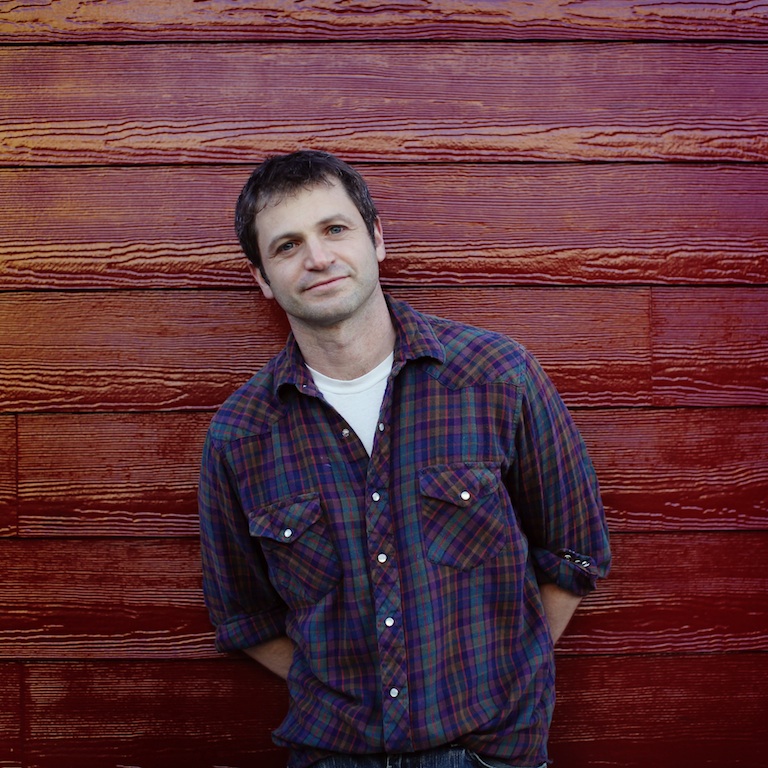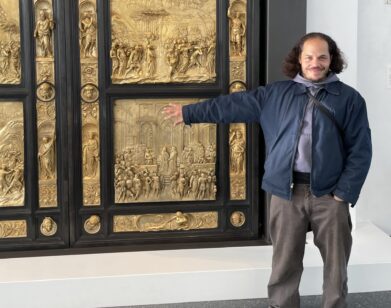Peter Orner and the Lives of Others

ABOVE: PETER ORNER. PHOTO COURTESY OF TRACI GRIFFIN.
“You think a story dies?” Walt Kaplan mentally mutters in “Last Car Over The Sagamore Bridge,” the titular story in Peter Orner’s second collection of short stories.
Like his predecessor Raymond Carver, Orner knows how to suggest a great deal with very little. With his specific titles— “Lubyanka Prison, Moscow, 1940” or “Paddy Bauler in a Quiet Moment,”—and succinct opening sentences, the Chicago-born writer drops his readers into his characters’ lives and does not wait for them to catch up. But Orner’s stories, which span the 1940s to the 1990s, Al Capone to Ted Kennedy, and Chicago to Mexico to Russia, are as much about the way in which they are told as the events they relate. A study of memory, myth, and survival.
Now 45, Orner has also written two novels, The Second Coming of Mavala Shikongo (2006) and Love and Shame and Love (2011), and currently teaches at San Francisco State University. We recently spoke with the author via phone.
EMMA BROWN: Do you have an earliest memory that you are willing to share?
PETER ORNER: Yeah. I sometimes wonder if our memories are a myth. We think we remember, but we are remembering the story and not the actual event? My parents took us to Europe when I was a real little kid—I was three or something. It was a disaster. I tried to push my older brother off of the Eiffel Tower. It’s just one of those family stories that gets told and told. But I actually remember being so pissed at him as to try to do that. He deserved it. He was needling me about things that I didn’t know.
BROWN: Did you have this theme of memory and how we tell stories in mind when you started writing the first story for this collection?
ORNER: I think it’s always been this sort of obsession. There’s a great Chekhov quote that I used in my second book, a novel about Namibia called The Second Coming of Mavala Shikongo. He says, “The Russian loves recalling life, but he does not love living.” That scene has always been something that I have held dear. When something happens, the first thing you want to do is tell it. That’s almost more exciting. It’s almost simultaneous with the experience; you are already telling something incredible while it’s happening. The stories that everybody carries around and repeats, I am really interested in that. Those are not necessarily the most exciting things that happened to them, they’re just things that stick. I really want to know what sticks.
BROWN: There’s that very famous quote at the beginning of Anna Karenina: “Happy families are very alike; every unhappy family is unhappy in its own way.” Do you feel that way about your stories? None of them are particularly upbeat.
ORNER: He knew what he was talking about. [laughs] I think that maybe happy families don’t need stories the way unhappy families need stories. Maybe they’re too busy living that they don’t actually step back and talk about life like the Chekhov quote. I prefer Chekhov to Tolstoy, and the reason is because of what he leaves out. Sometimes I think Tolstoy had a theory that he was proving and he proved it. Chekhov is more ambiguous, so I agree with the quote completely, but I also feel like there’s more to it. What is a happy family and an unhappy family? We’re probably both of those things at the same time.
BROWN: The settings of your stories are very specific. Do you usually start with a location?
ORNER: I usually have a location and then I put the character there. I love place names. I think I’m tricking myself by being so specific—it suddenly becomes real to me. Just because I say it’s Chicago, Illinois doesn’t mean it’s true, [but] place names sort of make me grounded and then I can put some people there.
BROWN: A few of your characters, like Walt and Esther, pop up throughout the collection. What made you keep coming back to these characters?
ORNER: Walt has been around for a long time. He has been around since my first book [Esther Stories, 2001]. He appears in Love and Shame and Love and he appears in this book a number of times, and then he’s in the new book I am writing. He’s a furniture salesman in Salt River, Massachusetts. He’s roughly based on my grandfather, who died at 59 [when] I was really young. I just had these incredibly vivid memories of him. He was what most people in the world would consider an ordinary guy—sold furniture. But I inherited all of his books, and through this book collection of his I feel like I’ve sort of gotten to know him. He was really eclectic. He didn’t go to college, but he had this incredibly curious mind that I only learned about after his death. And one of the weirdest things he did—I’ve written about this—is that he collected phone books, and he had every year of phone books from Salt River, Massachusetts. I was always wondering, “Why he would do that?” and I don’t know exactly, but I think that he was really interested in names. I like to think of him sitting there just reading all of these names of people, and maybe he knew some of them but most of them he didn’t. He’s sort of an alter ego; he’s someone who sits in his office and thinks about stuff. I think that’s sort of what I do.
BROWN: How much do you know about your characters? Obviously Walt’s different because he appears in a lot of your stories, but often your stories dive right in—do you know the beginning and the end yourself? Or are you discovering them as you’re writing and you only know as much as the reader knows?
ORNER: Maybe my work is somewhat divided into family stories, things I know intimately, and then everybody else in the world —the strangers who I am totally fascinated with. A particular story in the book [“Plaza Revolución, Mexico City, 6 A.M.”]—a little tiny story about a woman in Mexico City—she is just based on somebody who I saw walking through the square in the morning, and I wanted to know what her life was like. Of course I couldn’t just run up to her: A, my Spanish not being good enough and B, that’s not something you do. You don’t just go up to people and say, “Hey, what’s your story?” The image of this woman walking across this plaza at six o’clock in the morning—she was carrying television antennas to sell—the image of her stayed with me. I wanted to think about who she was. I don’t know everything about her, but I am curious. To me, and I’m sure for other writers, too, characters come back and they relive again, but what about those characters who only live for a page or two? Or for five pages or 10 pages. I like to think they’re still out there—still living—but for me they kind of die, too. It’s kind of sad. I don’t think about them anymore unless I give them life again.
BROWN: Do you ever re-read your books ever and think, “Oh my goodness, I completely forgot about this person I created?”
ORNER: [laughs] I try not to read my own books just because I would rather read somebody else. But my first book came out again this year—the re-issue from 2001. I was rereading it to make sure that I didn’t miss any mistakes, and I didn’t know who had written some of these stories. I really didn’t. I am a different person now. It’s weird. I think if stories are good, they have to have a life of their own that’s independent of the writer. I like to think of my characters out there in other peoples’ heads. That’s a nice thing to think about.
BROWN: What can do with a short story that you can’t do with a novel?
ORNER: So much. What you can do is punch someone in the gut, in the best of ways. [laughs] A novel is like a long relationship and a short story is a brief one that lingers—it lingers powerfully and maybe more powerfully. I think that’s true in a lot of cases, most long-term relationships compared to some of the briefer ones—the intensity of those brief ones that end, I think a short story is kind of like that. There’s a certain level of intensity that I think is different. That said, I try and write novels that have that. I’m constantly trying to figure out how to crack that mystery; how to make a novel that has a sense of immediacy of a short story. I try to do that and I’ll try it again, but I’ll never get it.
I feel like there are too many words in the world, and I think silence is so much more powerful than the glut of words. I find that even in long books that I love, there’s a lot that’s cut. Moby-Dick has incredibly intense, short chapters. It’s a long book, but [Herman Melville] cut out a ton. I like to think you can gain so much power by just shutting up and letting the people do their thing, but also letting the reader work. We don’t want emotion handed [to us]—that’s not emotion. You have to build and come from the reader’s soul. [laughs]
BROWN: As a professor, what do you tell your students on the first day of class?
ORNER: Number one: I can’t teach writing. Number two: people have to follow their own strangeness. The minute they start making their own vision of the world flattened out so everyone can read it, they lose. I encourage people to be as awkward and odd on the page to capture their own way of seeing the world and not trying to see the world for other people.
BROWN: Do you show drafts of your work to people, or do wait until you’ve finished?
ORNER: I’m pretty tight—I rewrite, in some cases, 70 to 80 times before I show it to people. I write by hand in my notebooks and number the drafts, so I know how crazy I can get with this. Some writers, like my teacher Marilynne Robinson, she only writes one draft. I’ve thought about this a lot; I think it’s because she writes it 80 times in her head before it comes out.
BROWN: Do you write every day? Do you get writer’s block?
ORNER: I write when I have something to say and not when I don’t. My time is better spent if I know I have nothing to say. I don’t consider it writer’s block; I just don’t have anything to say. I think some writers should wait for something to say. [laughs]
LAST CAR OVER THE SAGAMORE BRIDGE COMES OUT TODAY, AUGUST 6, AND IS AVAILABLE TO ORDER VIA AMAZON AND OTHER RETAILERS.






